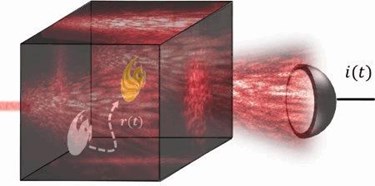Fluctuations In Optical "Noise" Used To Track Hidden Objects
By Jof Enriquez,
Follow me on Twitter @jofenriq

A new remote sensing method devised by researchers at the University of Central Florida (UCF) using fluctuations in optical "noise" could one day complement existing technologies to track hidden objects, such as Light Detection and Ranging (LIDAR).
Similar in operation to radar, but using infrared laser light instead of microwaves to detect particles and distant objects, LIDAR has several applications in scientific, military, and civilian endeavors. However, it requires a line of sight between the object and the sensor, and its precision falters when encountering conditions that scatter light, like fog or clouds. Newer remote sensing techniques, meanwhile, involve taking snapshots of objects using complex optical instruments and performing data calculations to pinpoint the location and movement of objects over time.
While these methods are proven effective under ideal conditions, scientists at UCF believe that they have a better way to detect objects when these are hidden behind scattering media.
“We are promoting a paradigm shift,” said Dr. Aristide Dogariu, who is the Pegasus Professor of Optics & Photonics at the Center for Research and Education in Optics and Lasers (CREOL) at the University of Central Florida, and leader of the research team. “Instead of illuminating the object with a coherent beam of light, we’re illuminating it with random, or noise-like light. Looking at how the fluctuations of the light are modified by the interaction with the object allows us to retrieve information about the object.”
To test their technique, the researchers shone a beam of light onto a plastic box containing a small object, which scatters the light inside and back through the walls of the enclosure. An integrating detector outside the box then collects light, which is analyzed for fluctuations caused by the object. An algorithm differentiates this optical "noise" from natural noise in the environment.
“The advantage of recovering information based on fluctuations is that it is more robust against external perturbations,” said Dogariu, in a press release. “It is robust against disturbances between the light source and the object and between the object and the receiver.”
The system is precise enough that it can track the object's center of mass as it moves in all degrees of freedom (left-right, up-down, and diagonal). But while it can provide scientists with the object's speed and direction, it is unable to provide data regarding its properties, such as color, material or shape.
“You cannot recover detailed information with this method, but if you simplify the question to what you really need to know, you can solve certain task-oriented problems,” said Dogariu, who, along with co-author Milad I. Akhlaghi, wrote about their research in the journal Optica.
They plan to expand their experiments involving larger scenes and scenes with lower levels of incoming light. The researchers believe their noise-based remote-sensing method will eventually find useful applications in biomedicine and other domains.
